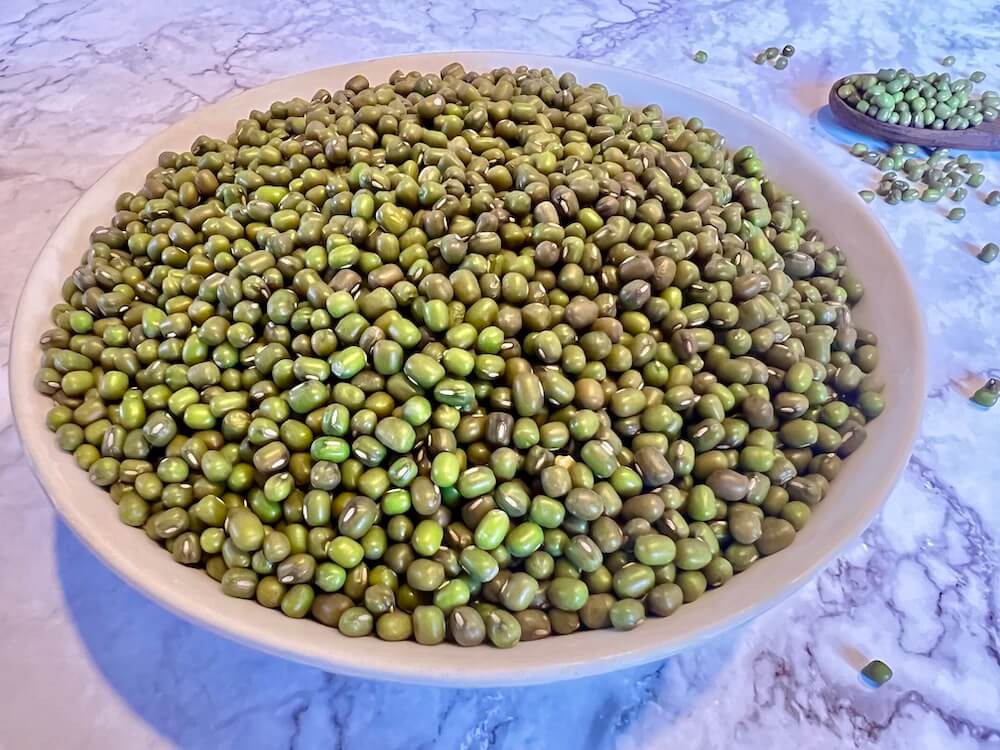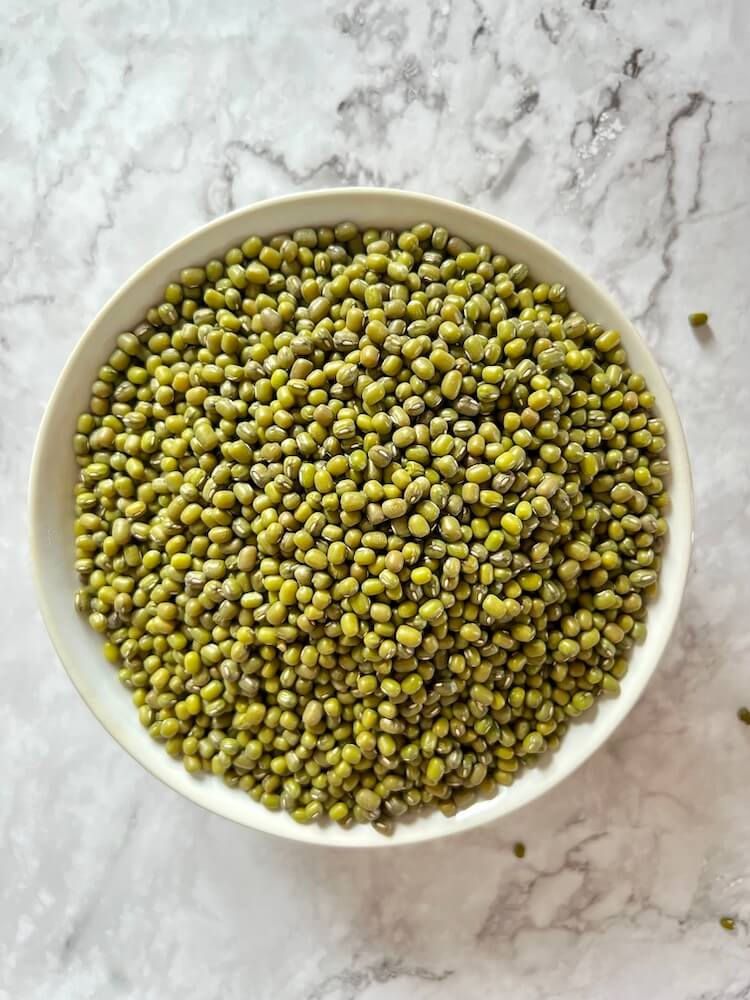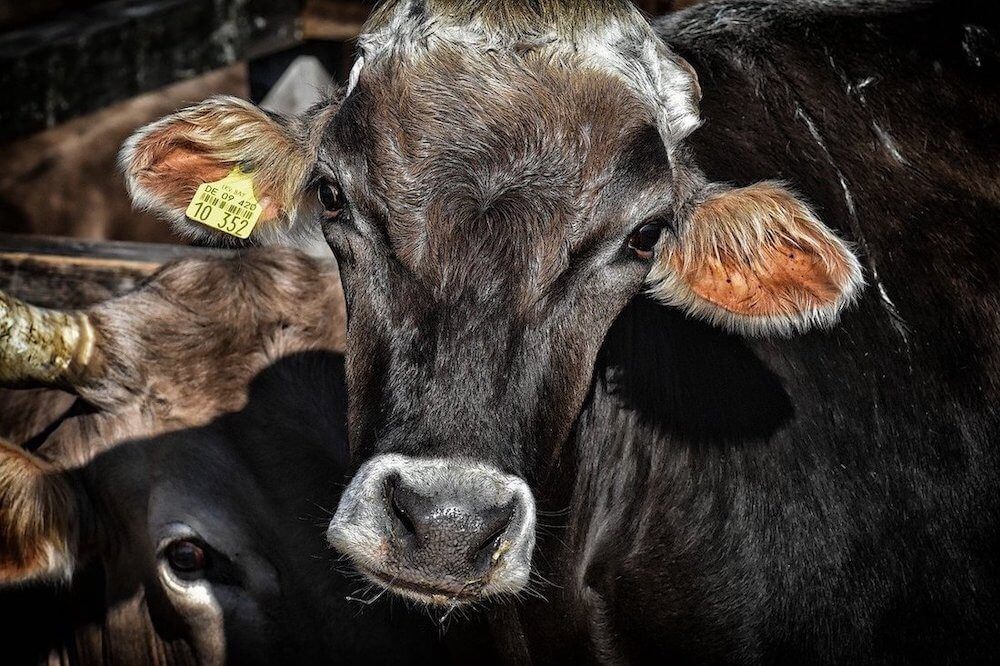How do you eat mung beans? Answer: in almost every way you can imagine possible.
And why should you eat mung beans? Because they’re delicious little beans which are easily digestible, packed with healthy nutrients and a great source of plant protein. And to top it off, they’re easy to cook.
Here we’ll look at mung beans, their nutritious properties, how to cook and how to eat them.
Mung beans are delicious, nutritious, easy to cook and so versatile you can make many types of sweet or savoury foods and benefit from their health-promoting properties.
Table of Contents
What are Mung Beans?
Mung beans (Vigna radiata) are part of the legume family and are a small green legume with an abundance of health benefits.
They’re widely eaten in the Philippines, India, China and all over Southeast Asia. India is the biggest producer of mung beans but they are also produced in China and southeast Asia too, as well as (to a lesser degree) in other places in the world, such as California.

What’s Another Name for Mung Beans?
Mung beans have many names depending on which which country the name originally comes from.
Among other names, they’re also called Moong beans, Green Gram, Maash, Monggo, Munggo and green soybeans – even though they are not soya beans!
Mung beans are also sold de-husked and split in half and are then bright yellow in colour after the green outer husk has been removed, and they’re called Mung Dahl (or Moong dahl).
For this post we’re going to call these little green beauties mung beans.
How do You Eat Mung Beans?
Mung beans are super nutritious and versatile. They can be cooked in so many ways, it may just surprise you how many.
So are you ready?
Here goes. . .
Mung beans can be cooked in water and served as a bean in its own right, as an addition to a salad or as the main ingredient of the salad or served with rice, for example.
They are widely used for making nutritious soups, stews and curries.
Mung dahl (or dal) is an extremely popular and well known dish made from mung beans which have had the green husk removed. Mung dahl cooks quicker and becomes a mushy dahl sooner than the whole mung beans with their husks.
Mung bean paste is used for making a dosa (or mung bean crepe) which can be served stuffed or on a side, plus mung beans can be used to make bread and mung bean pancakes.
And don’t forget about mung bean hummus.
As well as the more normal ways of cooking mung beans, they can also be used to make sweet desserts, ice-cream or a sweet mung bean drink.
In China in the summer, mung beans are boiled up into a thin milk-like drink and kept in the fridge to drink throughout the day to protect the body from the risk of heatstroke.
And we mustn’t forget the sprouted mung bean and all its healthful uses. I mean bean sprouts are just delicious, so they’re a super important part of how to eat mung beans.
Finally, mung beans are ground up into flour and can be used to make tempeh.
So there you have it, the many ways of including these delicious green nutrition bombs into your life.
Summary: How do you Eat Mung Beans?
- boiled mung beans
- mung bean soup
- mung bean curry
- mung bean stew
- mung bean salad
- mung bean dahl
- mung beans and rice mixed
- mung bean dip
- mung bean crepes and pancakes
- mung bean paste
- mung bean bread
- mung bean drink
- desserts made from mung beans
- sprouted mung beans
- mung bean flour
- mung bean tempeh

Are Mung Beans Healthy?
Mung beans are loaded with antioxidants and are an excellent source of plant protein, as well as providing plenty of phytonutrients, vitamins and minerals.
In fact, mung beans have so many diverse health benefits, putting them right up there as a food which you might want to consider including in your meal plans.
Mung beans are packed with protein and folate. Just 1 just cup (202g) will provide 80% of the daily recommendation of folate. They’re also rich in manganese, magnesium, vitamin B1 (thiamine), phosphorus, iron, potassium, calcium and zinc.
They also contain vitamins B2 (riboflavin), B3 (niacin), B5 (pantothenic acid), B6 (pyridoxine) and selenium.
Apart from being healthy and nutritionally loaded, mung beans are more easily digested than other beans and may help to lower bad cholesterol, protecting the cardiovascular system.
But the list doesn’t stop there.
They also help to reduce blood pressure, aid in promoting a healthy digestive system, lower blood sugar levels, promote weight loss, provide essential folate to promote a healthy pregnancy, defend against heat stroke and reduce the risk of chronic diseases.
They have anti-inflammatory, anti-microbial, anti-fungal and antibiotic properties.
And their antioxidant properties help fight cancer and lower the risk of cancer related deaths through their anti-tumour activity which protects from the danger of cell mutation. See 2018 study published in Clinical Nutrition
Whew, that’s quite a lot of power in a little green pellet-like bean!
Conclusion: Are Mung Beans Healthy?
Mung beans are an extremely healthy food. Listed below are their primary qualities. . .
- a great source of plant protein
- packed with phytonutrients and antioxidants
- rich source of folate
- provide vitamins B1, B2, B3, B5 & B6 as well as other vitamins and minerals
- protect the cardiovascular system and may help to lower bad cholesterol
- easily digested and can promote a healthy digestive system
- lower blood sugar levels
- promote weight loss
- support a healthy pregnancy
- protect against heat stroke
- reduce the risk of chronic disease
- anti-inflammatory, anti-microbial, anti-fungal and antibiotic properties
Are Mung Beans Good for Weight Loss?
Mung beans are great for supporting weight loss because of the high fibre, rich protein content, antioxidants and phytonutrients.
When you follow a whole foods plant based lifestyle, you can approach eating in a different way, and instead of counting calories you just make sure you eat whole foods like these mung beans.
On a whole foods plant based diet (it isn’t a ‘diet’) you don’t need to calorie count and you build a positive relationship with your food. Mung beans are part a healthy whole foods plant based lifestyle and can promote healthy weight loss.
They are naturally high in protein which many people find beneficial for weight loss, and high in fibre which can help you to feel fuller for longer, as well as being a well rounded nutritious food.
For anyone who wants to count the calories, mung beans are slightly lower in calories than their counterparts and sprouted mung beans have an even lower calorie count.
Are Mung Beans Hard to Digest?
Mung beans are easy to digest and can help promote a healthier digestive system. The carbohydrates in mung beans are also easier to digest than in the bean-relatives, causing less problems with bloating and excess gas than other legumes tend to do.
In Chinese medicine, mung beans have been used for many years for treating gastric issues and returning the digestive system back to health.
Are Mung Beans Used for Detoxifying?
Mung beans have long been used for detoxifying throughout Asia, and in Chinese medicine mung beans are also used for their detox properties.
The tannins and flavonoids in mung beans can help clear out heavy metals from our systems, such as mercury and lead.
Many people use mung beans as a detoxifying food such as eating only mung bean soup for a few days to detoxify the system. Try a mung bean soup cleanse and see how great you feel!
A mung bean cleanse is a detox diet you may like to do if you’re looking to take a break from alcohol for example.
The health promoting properties of mung beans is not so widely recognised in the west as it is in the east, where it’s been a staple part of the diet and the medicine cupboard throughout the years of history.
Do Mung Beans Have an Anti-inflammatory Effect?
Mung beans have an anti-inflammatory effect which can protect against general inflammatory conditions including inflammation of the skin, such as rashes, sores or pimples. (see this study)
As well as the anti-inflammatory effect they are antimicrobial, antibiotic and anti-fungal. (source)
Can I Cook Mung Beans Without Soaking Them First?
Some recipes online say you should soak mung beans before cooking them, but it isn’t necessary unless you want to make a smooth mung bean paste and are soaking them to improve the final texture of the paste (depending on the efficacy of your food processor or blender).
Also, if you have issues with your digestive system, soaking beans is a good idea because it can reduce the anti-nutrients and make them more easily digestible.
Remember, you don’t want to soak them for too long or they will begin to ferment. And the length of time you soak for will also depend on the temperature of the room. In hot climates, it’s best to soak any legume in the fridge to avoid spoiling them through fermentation.
Generally, we soak legumes overnight, but mung beans being so much smaller, they can be soaked for a shorter period of time.
Personally I cook them without prior soaking and despite my issues with my digestive system, I’ve never had a problem with mung beans, not even causing gas.
Conclusion: should I soak mung beans before cooking?
- cook the mung beans without prior soaking
- soak for a few hours if you want to achieve a smoother blended paste
- soak for a few hours if you have digestive issues
- in hot climates, soak in the fridge to avoid spoiling the bean by fermentation

How to Cook Mung Beans
You’ll be pleased to know that mung beans are super simple to cook. Absolutely no faff involved!
You should remember that you can choose for a softer or a firmer final result. For a dahl type effect you’ll want the mung beans extra soft and in a stew they can also be soft, but for sprinkling over salads you’ll want them just that little bit al-dente.
There are various ways you can choose to cook your mung beans.
First, you’ll want to run the mung beans under running water to wash them and check them for anything inedible just incase a piece of grass or bit of stone got in with them and remove anything you might find.
Next, choose your cooking method.
Boiling Mung Beans on the Stove Top
Put the mung beans into a pan and cover with 3 parts water to 1 part beans. Bring to the boil, then reduce heat and simmer for about 20 minutes.
Check the beans and continue to cook until they have the desired consistency.
Mung Beans in the Slow Cooker
You can cook mung beans in the slow cooker just like you would any other bean, only these will cook faster than their larger counterparts like kidney beans etc.
Simply add your washed beans to the slow cooker along with any other ingredients you want to cook them with and turn on the slow cooker to high. Leave to cook for around 3.5 hours.
Cooking Mung Beans in the Rice Cooker
This is my preferred method to cook mung beans. It’s so simple! Measure your beans using the rice cooker measurement, then add the water according to the rice cooker, plus an extra measure than you would if you were cooking rice.
So if you cook 2 rice cups of beans, fill the rice cooker up to level 3. This is only an approximation and you will need to practise with your own rice cooker as they are all different. I have even cooked the beans in the rice cooker without measuring the water, just making sure that it generously covers the beans.
The secret is, not to leave it up to the rice cooker to turn off. Instead, after it’s been boiling for about 20 minutes you’re going to open the lid of the rice cooker and take a look. Are the mung beans soft yet? Is there much liquid left?
I aim for there to be some liquid left when the mung beans are soft and I turn off the rice cooker manually.
I then use the mung beans and the liquid in whatever I’m cooking.
Black Rice with Mung Beans in the Rice Cooker

I absolutely love this dish. Measure out the quantity of black rice and mung beans you want to cook. For example, 2 cups black rice and 1 cup of mung beans.
Wash the black rice and the mung beans and transfer both to your rice cooker.
Fill the rice cooker up to mark 4 (1 cup more than the quantity you would need if you were only cooking rice) and switch it on as normal.
After 30 minutes, lift the lid and check the rice and mung beans.
I should take about 45 minutes to reach perfection, but as rice cookers vary and the exact amount of water vs rice/mung beans will also vary, I recommend you check them from 30 minutes onwards and turn off the rice cooker when you see the results you want.
I love eating this just as it is but you can also make a vegetable stir fry to serve with it.
Note: you can’t cook white rice and mung beans together because the beans take longer to cook than the rice, but black rice takes longer to cook so it can be done in the rice cooker with the mung beans.
If you want to make the dish with brown or white rice, it’s best to cook the mung beans separately.
All About Mung Beans
Conclusion on How do You Eat Mung Beans?
Mung beans are tasty and versatile. You can include them in almost any type of dish that you’re preparing, for an added nutritional boost and a high profile of plant protein.
Once you start incorporating these little gems into your life, my bet is that you won’t look back.
Cheap to buy, easy to cook, healthy and beneficial . . . it’s an easy one. Mung beans are here to stay.







